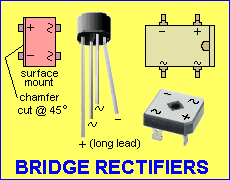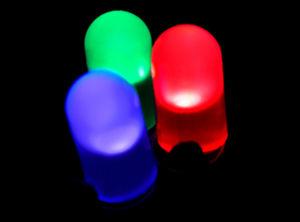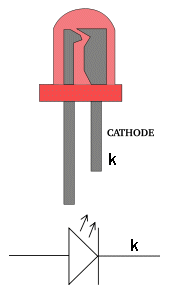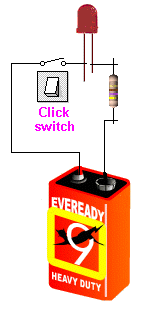|
5. Diodes
As with transistors, diodes are fabricated from semi-conducting
material. So, the first letter in their identification is A for germanium
diode or B for silicon diode. They can be encased in glass, metal
or a plastic housing. They have two leads: cathode (k) and an anode (A).
The most important property of all diodes is their resistance is very
low in one direction and very large in the opposite direction.
When a diode is measured with a multimeter and it reads a low value of
ohms, this is not really the resistance of the diode. It represents the
voltage drop across the junction of the diode. This means a multimeter
can only be used to detect if the junction is not damaged. If the
reading is low in one direction and very high in the other direction, the
diode is operational.
When a diode is placed in a circuit and the voltage on the anode is
higher than the cathode, it acts like a low value resistor and current
will flow.
If it is connected in the opposite direction it acts like a large value
resistor and current does not flow.
In the first case the diode is said to be "forward biased" and in the
second case it is "reverse biased."
Figure 5.1 shows several
different diodes:

Fig. 5.1: Several different types of
diodes
The diodes above are all single diodes, however 4 diodes are available
in a single package. This is called a BRIDGE or BRIDGE RECTIFIER.
Examples of a bridge are shown in the diagram below:

You must be able to identify each of the 4 leads on a bridge so that
it can be inserted into a circuit around the correct way. The
surface-mount device above is identified by a cut @ 45° along one side.
The leaded bridge has one leg longer than the others and the top is
marked with AC marks and "+." The high-current bridge has a corner cut
off and the other surface-mount device has a cut or notch at one end.
These devices are added to a circuit as shown in the next diagram:

The 4 diodes face the same direction and this means a
single diode can be shown on the circuit diagram:

Symbols in 5.2 show a number of diodes. There are a number of
specially-designed diodes: for high current, high-speed, low
voltage-drop, light-detection, and varying capacitance as the voltage is
altered. Most diodes are made from silicon as it will withstand high
temperature, however germanium is used if a low voltage-drop is
required. There is also a light emitting diode called a LED, but this is
a completely different type of diode.

Fig. 5.2: Diode symbols: a - standard diode, b -
LED,
c, d - Zener, e - photo, f,g - tunnel, h - Schottky, i -
breakdown,
j - capacitative
LEDs (Light Emitting Diodes) are constructed from a
crystalline substance that emits light when a current flows through it.
Depending on the crystalline material: red, yellow, green, blue or
orange light is produced. The photo below shows some of the colours hat
can be produced by LEDs:

It is not possible to produce white light from any of
these materials, so a triad of red, blue and green is placed inside a
case and they are all illuminated at the same time to produce white
light. Recently, while light has been produced from a LED by a very
complex and interesting process that can be found on Wikipedia.
LEDs have a cathode and anode lead and must be connected to DC around
the correct way. The cathode lead is identified on the body
by a flat-spot on the side of the LED. The cathode lead is the shorter
lead.

One of the most important things to remember about a LED is the
characteristic voltage that appears across it when connected to a
voltage. This does not change with brightness and cannot be altered.
For a red LED, this voltage is 1.7v and if you supply it with more than
this voltage, it will be damaged.
The easy solution is to place a resistor on one lead as shown in the
diagram below:

The LED will allow the exact voltage to appear across it
and the brightness will depend on the value of the resistor.
Zener diodes (5.2c and 5.2d) are
designed to
stabilize a voltage. Diodes marked as ZPD5.6V or ZPY15V have operating
voltages of 5.6V and 15V.
Photo diodes (5.2e) are constructed in a way that
they allow light to fall on the P-N
connection. When there is no light, a photo diode acts as a regular diode.
It has high resistance in one direction, and low
resistance in opposite direction. When there is light, both resistances are
low. Photo diodes and LEDs are the main items in an optocoupler (to be discussed in more detail in chapter
9).
Tunnel diodes (5.2f and 5.2g) are commonly used in oscillators
for very high frequencies.
Schottky diodes
(5.2h) are used in high frequency circuits and for its low voltage drop in
the forward direction.
Breakdown diodes (5.2i)
are actually Zener diodes. They are used in various devices for protection
and voltage regulation. It passes current only when voltage rises above
a pre-defined value.
A Varicap diode (5.2j) is used instead of a
variable capacitor in high frequency circuits. When the
voltage across it is changed, the capacitance between cathode and anode is
changed. This diode is commonly used in radio receivers, transceivers
and oscillators.
The cathode of a low power diode is marked with a ring painted on the
case, but it is worth noting that some manufacturers label the anode this
way, so it is best to test it with a multimeter.
Power diodes are marked
with a symbol engraved on the housing. If a diode is housed in a
metal package, the case is generally the cathode and anode is the
lead coming from the housing.
5.1
Diode identification
European diodes are marked using two or three letters and a number.
The first letter is
used to identify the material used in manufacturing the component (A -
germanium, B - silicon), or, in case of letter Z, a Zener diode.
The
second and third letters specify the type and usage of the diode. Some of
the varities are:
A - low power diode, like the AA111,
AA113, AA121, etc. - they are used in the detector of a radio
receiver; BA124, BA125 : varicap diodes used instead of variable
capacitors
in receiving devices, oscillators, etc., BAY80, BAY93, etc. -
switching diodes used in devices using logic circuits.
BA157, BA158, etc. - these are switching diodes with short recovery
time.
B - two capacitive (varicap) diodes in the same housing, like
BB104, BB105, etc.
Y - regulation diodes, like BY240, BY243, BY244,
etc. - these regulation diodes come in a plastic packaging and operate
on a maximum current of 0.8A. If there is another Y, the diode is intended for higher
current. For example, BYY44 is a diode whose absolute maximum current
rating is 1A. When Y is the second letter in a Zener diode mark (ZY10,
ZY30, etc.) it means it is intended for higher current.
G,
G, PD - different tolerance marks for Zener diodes. Some of these are ZF12
(5% tolerance), ZG18 (10% tolerance), ZPD9.1 (5% tolerance).
The third
letter is used to specify a property (high current, for
example).
American markings begin with 1N followed by a number,
1N4001, for example (regulating diode), 1N4449 (switching diode),
etc.
Japanese style is similar to American, the main difference is
that instead of N there is S, 1S241 being one of them.
5.2
Diode characteristics
The most important characteristics when using power diodes is the maximum current
in the forward direction (IFmax), and maximum voltage in
the reverse direction (URmax).
The important characteristics
for a Zener diode are Zener voltage (UZ), Zener current (IZ) and maximum
dissipation power (PD).
When working with capacitive diodes it is
important to know their maximum and minimum capacitance, as well as values
of DC voltage during which these capacitances occur.
With LEDs it
is important to know the maximum value of current it is capable of passing.
The natural characteristic voltage across a LED depends on the colour
and starts at
1.7V for red to more than 2.4v for green and blue.
Current starts at 1mA for a very small glow and goes to about 40mA. High
brightness LEDs and "power LEDs" require up to 1 amp and more. You must
know the exact current required by the LED you are using as the wrong
dropper resistor will allow too much current to flow and the LED will be
damaged instantly.
The value of this resistors will be covered in another chapter.
Beside universal transistors TUN and TUP (mentioned in
Chapter 4.4), there are universal diodes as well. They are marked with DUS
(for universal silicon diode) and DUG (for germanium) on circuit
diagrams.
DUS = Diode Universal Silicon
DUG = Diode Universal Germanium
5.3 Practical examples
The diagram of a power supply in figure (3.8) uses several diodes. The
first four are in a single package, identified by B40C1500. This is a bridge rectifier.
The LED in the circuit indicates the transformer is working.
Resistor R1 is used to limit the current through the LED and the brightness
of the LED indicates the approximate voltage.
Diodes marked 1N4002 protect
the integrated circuit.
Figure 5.3 below shows some other examples of diodes. The life of a
globe can be increased by adding a diode as shown in 5.3a. By simply
connecting it in series, the current
passing through the globe is halved and it lasts a lot longer. However the
brightness is reduced and
the light becomes yellow. The Diode should have a reverse voltage of over 400V, and a current higher than the
globe.
A 1N4004 or BY244 is suitable.
A very simple DC
voltage stabilizer for low currents can be made using 5.3c
as a reference.

Fig. 5.3: a - using a diode to prolong the light bulb's
life span, b - stair-light LED indicator,
c - voltage
stabilizer, d - voltage rise indicator, e - rain noise synthesizer, f
- backup supply
Unstabilized voltage is marked "U", and stabilized with "UST."
Voltage on the Zener diode is equal to UST, so if we want to achieve
a stabilized 9V, we would use a ZPD9.1 diode. Although this stabilizer
has limited use it is the basis of all designs found in power supplies.
We can also devise a voltage overload detector
as sown in figure 5.3d. A LED
indicates when a voltage is over a predefined
value. When the voltage is lower than the operating voltage of the Zener,
the zener acts as a high value resistor, so DC voltage on the base of the
transistor is very low, and the transistor does not "turn on." When
the voltage rises to equal the Zener voltage, its resistance is lowered,
and transistor receives current on its base and it turns on to illuminate the LED. This example
uses a 6V Zener
diode, which means that the LED is illuminated when the voltage reaches that value. For
other voltage values, different Zener diodes should be used. Brightness
and the exact moment of illuminating the LED can be set with the value
of Rx.
To modify this circuit so
that it signals when a voltage drops below some predefined level, the Zener diode and Rx
are swapped. For example, by
using a 12V Zener diode, we can make a car battery level
indicator. So, when the voltage drops below 12V, the battery is ready for recharge.
Figure 5.3e shows a noise-producing circuit, which produces a rain-like sound. DC current flowing
through diode AA121 isn't absolutely constant and this creates
the noise which is amplified by the transistor (any NPN transistor) and passed
to a filter (resistor-capacitor circuit with values 33nF and 100k).
Figure 5.3f shows a battery back-up circuit. When the "supply"
fails, the battery takes over.
|








